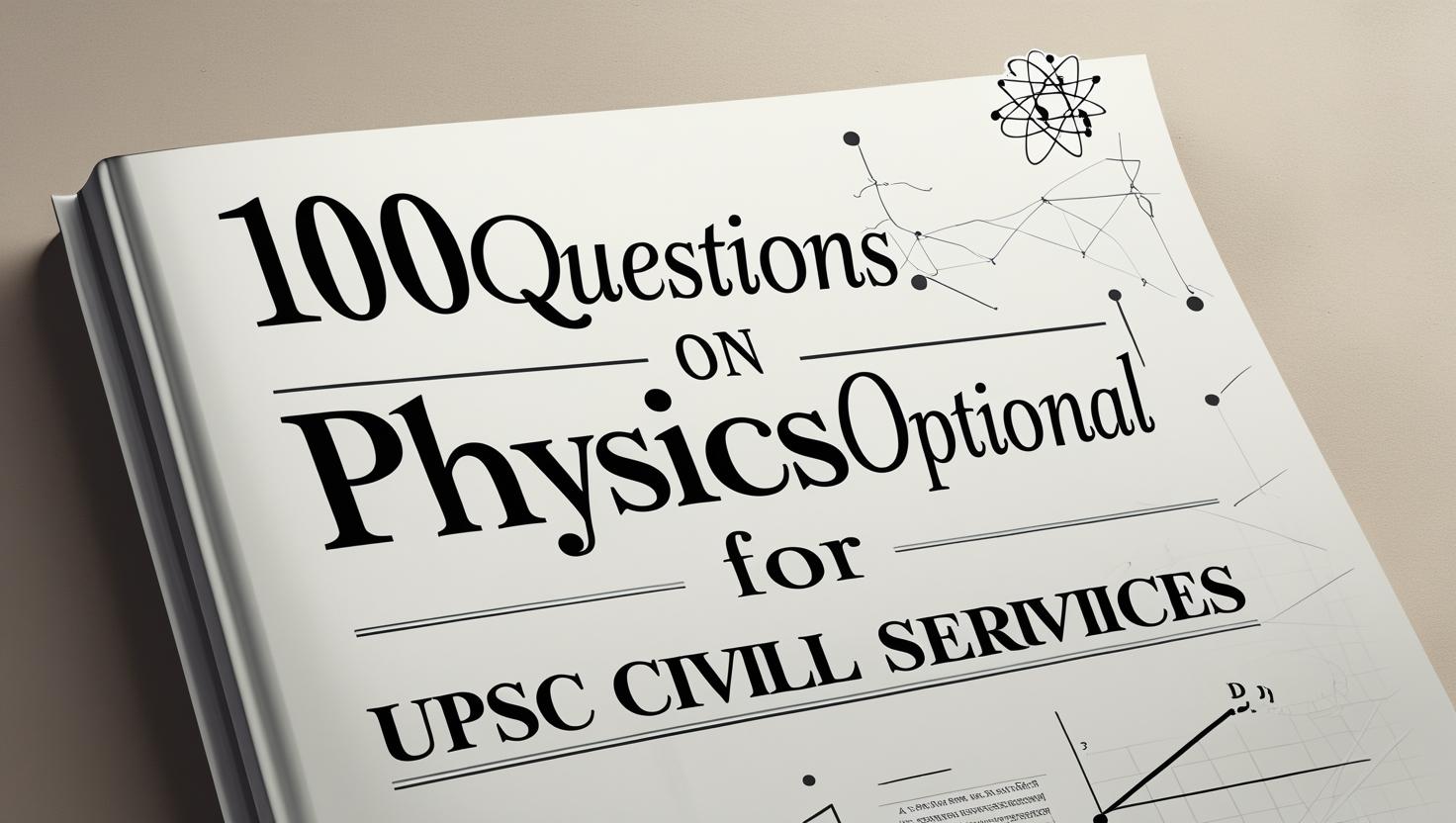Introduction
Physics is one of the most logical and scoring optional subjects in the UPSC Civil Services Examination. With clear concepts, structured preparation, and consistent practice, aspirants can master this subject. Below is a compilation of 100 practice questions, divided chapter-wise according to the UPSC syllabus.
For UPSC Coaching , Join FIRST IAS INSTITUTE (India’s Top IAS Coaching)
Chapter 1: Mechanics and General Properties of Matter
- State and explain D’Alembert’s principle with applications.
- Derive Lagrange’s equations from Hamilton’s principle.
- Explain the concept of generalized coordinates with examples.
- Derive the equation of motion for a simple pendulum using Lagrangian formulation.
- Write a note on the motion of a rigid body about a fixed axis.
- Derive the Euler’s equations of rigid body dynamics.
- Explain the concept of moment of inertia and parallel axis theorem.
- Discuss the theory of small oscillations with two degrees of freedom.
- Derive the Hamilton’s equations of motion.
- Explain Poisson brackets and their properties.
Chapter 2: Waves and Oscillations
- Derive the equation for a vibrating string and its normal modes.
- Explain the concept of dispersion relation in waves.
- Derive the equation of a damped harmonic oscillator.
- Discuss the resonance phenomena in forced oscillations.
- Write a note on coupled oscillators.
- Explain the concept of group velocity and phase velocity.
- Derive the normal modes of vibration for a two-particle system.
- Discuss the theory of transverse waves on a string.
- Explain beats phenomenon with derivation.
- Derive the expression for quality factor in oscillations.

3: Electricity and Magnetism
- Derive Gauss’s law and apply it to find the electric field due to a spherical charge distribution.
- State and explain Poisson’s and Laplace’s equations in electrostatics.
- Derive the expression for potential due to a dipole.
- Explain boundary conditions for electric and magnetic fields.
- Derive the Biot-Savart law and apply it to a circular loop.
- Derive the expression for magnetic vector potential.
- Explain the concept of displacement current and its significance.
- Derive Maxwell’s equations in differential form.
- Discuss Poynting theorem and its applications.
- Derive the electromagnetic wave equation in free space.
Chapter 4: Optics
- Derive the condition for interference in thin films.
- Explain Fresnel’s biprism experiment.
- Derive the expression for diffraction pattern due to a single slit.
- Discuss the resolving power of a telescope.
- Derive the expression for diffraction grating and its resolving power.
- Explain the concept of polarization by reflection and refraction.
- Discuss Malus’s law and its applications.
- Explain the working of Nicol prism.
- Derive the condition for constructive and destructive interference in Young’s double-slit experiment.
- Discuss Rayleigh criterion for resolution.
Chapter 5: Thermal and Statistical Physics
- Derive the Maxwell-Boltzmann distribution law.
- Explain the concept of partition function.
- Derive the relation between entropy and probability.
- Discuss the equipartition theorem of energy.
- Derive Planck’s law of blackbody radiation.
- Explain the concept of Bose-Einstein statistics.
- Derive the Fermi-Dirac distribution function.
- Discuss the concept of specific heat in solids using Debye’s theory.
- Explain the concept of entropy in thermodynamics.
- Derive the Clausius-Clapeyron equation.
6: Quantum Mechanics
- Derive the Schrödinger time-independent wave equation.
- Discuss the concept of probability density and current.
- Solve the Schrödinger equation for a particle in a one-dimensional box.
- Derive the energy levels of a quantum harmonic oscillator.
- Discuss the concept of angular momentum operators in quantum mechanics.
- Derive the commutation relations for angular momentum operators.
- Solve the Schrödinger equation for a hydrogen atom.
- Discuss the concept of spin and Pauli exclusion principle.
- Derive the expression for tunneling probability in a potential barrier.
- Explain Heisenberg’s uncertainty principle with examples.
Chapter 7: Atomic and Molecular Physics
- Derive the Bohr’s theory of hydrogen atom.
- Discuss Sommerfeld’s relativistic correction to Bohr’s model.
- Explain fine structure in hydrogen spectra.
- Derive the expression for Zeeman effect.
- Explain Stark effect with derivation.
- Discuss the Franck-Condon principle.
- Explain the concept of rotational spectra of diatomic molecules.
- Derive the vibrational energy levels of a harmonic oscillator molecule.
- Discuss Raman effect and its applications.
- Explain the concept of electronic transitions in molecules.
Chapter 8: Nuclear and Particle Physics
- Derive the semi-empirical mass formula.
- Explain the concept of binding energy per nucleon.
- Discuss the theory of radioactive decay.
- Derive the expression for the law of radioactive disintegration.
- Explain the concept of nuclear fission with energy calculation.
- Discuss nuclear fusion and its astrophysical importance.
- Derive Fermi’s theory of beta decay.
- Explain parity violation in weak interactions.
- Discuss the classification of elementary particles.
- Explain the quark model of hadrons.

9: Solid State Physics and Electronics
- Derive Bragg’s law of X-ray diffraction.
- Discuss the concept of reciprocal lattice.
- Derive the Kronig-Penney model for energy bands.
- Explain the concept of effective mass of electrons.
- Derive the expression for density of states in a 3D solid.
- Explain the concept of intrinsic and extrinsic semiconductors.
- Discuss the Hall effect and its applications.
- Derive the expression for conductivity in metals using Drude model.
- Explain p-n junction diode characteristics.
- Discuss the working of a transistor as an amplifier.
Chapter 10: Advanced Topics and Relativity
- Derive Lorentz transformation equations.
- Explain time dilation and length contraction with examples.
- Derive the velocity addition theorem in special relativity.
- Discuss mass-energy equivalence principle.
- Derive the expression for relativistic energy and momentum.
- Explain the Michelson-Morley experiment and its significance.
- Derive Einstein’s field equations in general relativity.
- Discuss the concept of Schwarzschild radius and black holes.
- Explain gravitational waves and their detection methods.
- Discuss the principle of equivalence in general relativity.
Conclusion
Physics optional for UPSC Civil Services requires both conceptual clarity and mathematical rigor. The above 100 questions are framed to help aspirants cover the syllabus comprehensively. Regular practice of such questions will build confidence and strengthen problem-solving skills, ensuring better performance in the examination.
Also Visit – Best IAS Coaching in India
For Answer Writing Techniques – Join FIRST IAS INSTITUTE

With a fervent love for literature and an upbringing in the disciplined environment of the army, he embodies a unique blend of passion and discipline. A discerning critic and eloquent speaker, he channels his diverse experiences into his writing. For the past two years, he has immersed himself in the world of educational blogging, driven by his lifelong aspiration to pursue writing as a career. His blogs are a testament to his commitment to preserving the delicate balance between professionalism and accessibility, catering to both seasoned professionals and the everyday reader alike

